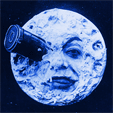Indian Crafts - Indian Village
Today I am happy to share two unusual photos (from 1956 I believe)! Frontierland's Indian Village was an educational environment, with various authentic native structures, the dance circle, the canoe landing, and talented craftspeople from different tribes. "Educational" does not equal "boring"; many vintage photos show the area packed with guests... it was a very popular place. Here are two photos from the Village!
I love this neat picture of a woman spinning yarn from wool, probably in the same manner as had been done for hundreds of years, if not longer. Next to her is a loom on which she is weaving a blanket in typical patterns and colors. I can't even imagine the patience and skill it takes to create something like that.
Nearby, another Indian pauses while in the middle of creating a sand painting. Beside him are small bags with different natural colors of sand... his "palette", so to speak. Navajo medicine men were famed for this art form, and according to Wikipedia, the paintings are used for healing purposes. Genuine sand paintings are considered sacred, so examples created for public viewing were often made with purposeful errors and reversed colors.

8 comments:
Great shots, the both of them. It certainly was a different time back then. And evidently those days have passed for good and we are all the poorer for it.
Thanks, Major.
Oh, how beautiful! I can't help wondering whatever happened to that blanket. Is it still around, somebody's treasured memory?
What nice up close images. There's more of a personal feeling to these than the usual Indian Village photos out there. Thanks.
Wow, terrific to see pictures from the old Indian village! These are treasures for sure, and I hope there are more in the batch.
"Educational does not equal boring" AMEN! There's proof you can do it right but unfortunately those in charge these days don't want to put forth that effort. Learning about Native American history is commonplace here in the Southwest, but I always wonder if visitors from other places in the country found it novel and fascinating.
I vaguely recall seeing these activities but I'm not sure if at Disneyland or somewhere else.
Hosting activities like these is what used to separate Disneyland from the rest of the amusement parks.
JG
Studying the history of the Southwest Indians, it is striking to see the parallels between their civilizations and the stone age Greeks.
Strong oral history and religious traditions, weaving, pottery, basketry, highly developed visual arts, all at approximately the level of Pre-Homeric Greece. (Look at the pots!). Trouble was, the Indians took over 2000 years to emigrate across Asia to America and so they were over 1500 years behind.
What civilization would these people have created if they had that 1500 years to continue developing undisturbed? The world will never know.
JG
Nanook, I was happy to find them, they are pretty unusual. And it is hard to imagine something like this in the Disneyland of today, unfortunately. Where are the thrills? Where are the pirates?
Melissa, I'd like to believe that the blanket is still around!
K. Martinez, the thing about these closeups is that instead of generic "Indians" we see this man and woman as people, which is an important distinction.
Tom, there is only one more from the Indian Village, though there are a few more good pix from this lot.
PsySocDisney, I assume that it is mostly a change in what the public expects or wants, although Walt seemed to have faith that if something was interesting to him, it would be to others as well. And he seemed to generally be right!
JG, I don't remember ever seeing this kind of thing - or even the old Dance Circle either, though I certainly go back far enough to have been able to. Maybe my folks just didn't know what was through that tunnel in Frontierland. As for the similarities between the Southwest Indians and the Greeks, I have the feeling that there are many cultures that developed in similar ways.
Post a Comment